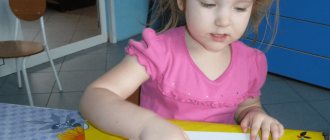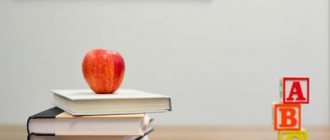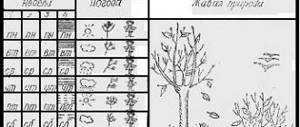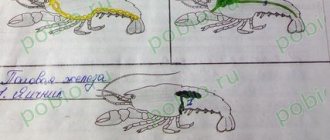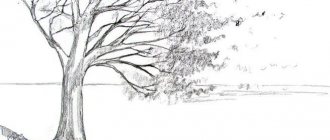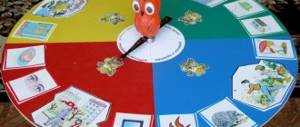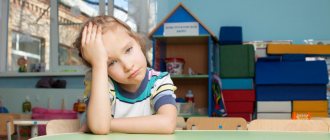Direct educational activities in preschool educational institutions according to the Federal State Educational Standard
Federal State Educational Standard is a federal state educational standard developed for the comprehensive development of the individual.
When drawing up a program for preschool institutions, the following are taken into account:
- individual capabilities and aspirations of the student,
- cooperation and desire for contact with adults,
- nature of interaction with children and adults,
- respectful attitude towards peers and parents.
The Federal State Educational Standard controls that the educational process is indirect; both the student and the adult must be involved in learning.
Previous strictly regulated forms of education are becoming more flexible, meeting the capabilities and needs of children of primary, middle and senior preschool age.
The main goals that the Federal State Educational Standard faces when raising children in preschools:
- physical development,
- speech development,
- development of communication skills,
- personal development,
- development of motivation,
- development of socialization,
- development of cognitive interest,
- development of artistic skills and aesthetic taste.
Children of early preschool age implement the above skills through educational games with composite toys, physical exercises, experiments with various substances, household items, communication with peers and older children. Together with the teacher, musical works, paintings, fairy tales and poems are analyzed.
For children of senior preschool age, didactic games are role-playing in nature, preschoolers learn to follow rules and hierarchy, classes are exploratory in nature, self-service is taught, and household work skills are developed. Folklore, history, and fiction are studied in the lessons.
The modern educational system involves not only natural, paper and other application materials. Information technology products are also included, problem situations projected in a game format are considered and played out.
The task of the teacher in this case is to organize the educational process in such a way that the child develops comprehensively, intellectually, socially, and shows interest in the world around him and initiative in work activities.
The essence of methods of education and training of preschool children
Methods of raising preschool children are scientifically based methods and techniques of pedagogically appropriate interaction between the teacher and children, aimed at organizing their effective activities and relationships that stimulate active cognitive behavior.
Methods of teaching children are certain methods of purposefully organized activities implemented by the teacher, during which students acquire specific knowledge, skills, abilities, shape their worldview and develop their innate abilities.
Educational methods must be distinguished from techniques.
Definition 1
Techniques (of training and education) are parts, elements and details of a specific method.
Methods of teaching and raising preschool children have their own specifics, which are determined by the characteristics of the preschool period.
The effectiveness of raising and teaching preschool children largely depends on the methods correctly selected by the teacher. When choosing a method of teaching and upbringing, the teacher must be guided by a number of rules; the methods must:
Finished works on a similar topic
- Course work Methods of teaching and educating preschoolers 480 rub.
- Abstract Methods of training and education of preschool children 220 rub.
- Test work Methods of teaching and educating preschoolers 240 rub.
Receive completed work or specialist advice on your educational project Find out the cost
- correspond to the age and level of development of children;
- accessible for the implementation of preschool educational institutions, that is, the material and technical base of the kindergarten should be taken into account;
- understandable and accessible to children.
In addition, the teacher must be able to use the chosen method in practice.
Each method of teaching and upbringing has two sides:
- The external side of the method is a total system of ways of influencing the child.
- The internal side of the method is the mental cognitive processes that underlie the method of action used.
Note 1
Thus, each method is a set of techniques aimed at solving certain didactic tasks (familiarization with new information, consolidation of completed educational material, creative processing of what has been learned, etc.).
Ways to organize children
All of the above problems are solved in various ways. Sometimes completely opposite approaches are taken for different children.
The following characteristics are taken into account in groups:
- variety of toys and equipment in kindergarten,
- age characteristics of children,
- safety of indoor conditions,
- level of physical fitness of children,
- teacher qualification level.
Physical exercises are taken as examples, but the process, goals, methods and teacher participation remain similar during educational lessons.
Frontal
The main goal of the pedagogical process is the acquisition and consolidation of children’s motor skills. They work actively and constantly interact with the teacher.
All movements are performed by children simultaneously and synchronously.
In large groups, it is difficult for an adult to pay attention to each student, and therefore improve the quality of movements.
Individual
Each exercise is performed alternately by children in a chain. While one does it, the rest observe and analyze.
The main advantage of the approach is the strict quality of execution. The main drawback is the passivity of other preschoolers. Effectively used at an older age to learn complex exercises.
In-line
To ensure high motor activity, children perform several exercises at once, in a circle, changing settings and equipment.
This is useful for developing endurance, but it is difficult for an adult to keep track of how each child performs the exercise correctly.
Group
Children are divided into several subgroups, where each performs their own task, after which they change. Useful for physical development and developing acceptance of responsibility for one’s actions.
In this method, the teacher has practically no opportunity to find and correct the student’s mistakes.
Forms of educational organization used in preschool educational institutions.
The form of organization of training is a joint activity of the teacher and students, which is carried out in a certain order and established mode.
Traditionally, the following forms of training organization are distinguished: group, frontal and individual. These are traditional forms. Everyone is accustomed to them, they have long been mastered by teachers, and are recognized by official pedagogy and educational authorities in all countries of the world. Each of the forms is distinguished by its specificity, which is expressed in the didactic goal, in the degree of independence of children, in the ratio of collective and individual work, in the features of pedagogical leadership.
| Forms of training organization | Peculiarities |
| Individual | Allows you to individualize learning (content, methods, means), but requires a lot of nervous effort from the child; creates emotional discomfort; uneconomical training; limiting cooperation with other children. But in some cases, individual lessons are necessary. First of all, this applies to children with developmental disabilities, who are often ill, and who have behavioral problems (restless, increased excitability, impulsive behavior, etc.). Individual lessons are also needed by children with clearly expressed abilities for a particular activity (drawing, singing, mathematics), and children with a dominant cognitive interest (in the world of technology, in animals). |
| Group (individual-collective) Attention! If you need help writing a paper, we recommend turning to professionals. More than 70,000 authors are ready to help you right now. Free adjustments and improvements. Find out the cost of your work. Cost calculationGuaranteesReviews | The group is divided into subgroups. Reasons for recruitment: personal sympathy, common interests, but not according to levels of development. At the same time, it is first of all important for the teacher to ensure the interaction of children in the learning process. The technology for conducting group classes may vary. Sometimes all subgroups are present at the lesson at once. In these cases, the teacher must think about how to accommodate the children. Each subgroup should sit compactly, but to some extent autonomously, at some distance from the others, because in such a lesson there will no longer be absolute silence; “within the subgroup” children communicate, talk, and interact. The topic of the lesson can be common to everyone (modeling based on the fairy tale “Kolobok”, making a model after finishing modeling). The lesson ends with a kind of exhibition of works. Each subgroup analyzes how the task was performed, and everyone evaluates the results together. |
| Frontal | Work with the whole group, clear schedule, uniform content. At the same time, the content of training in frontal classes can be activities of an artistic nature. The advantages of the form are a clear organizational structure, simple management, the ability for children to interact, and cost-effectiveness of training; The disadvantage is the difficulty in individualizing training. |
Meanwhile, it is a generally accepted fact that the leading form of organizing the education of preschool pupils is the lesson, and at school it is the lesson. The use of classes and lessons as the main form of teaching children was justified by Ya.A. Comenius.
Teaching in the classroom, regardless of the form of its organization, differs primarily in its programming.
The teacher outlines the program content that should be implemented during the lesson.
Traditionally, according to didactic objectives,
classes were divided into three groups: classes on mastering new knowledge and skills;
classes to consolidate previously acquired knowledge and skills; classes in creative application of knowledge and skills. Currently, complex classes predominate,
in which several didactic tasks are simultaneously solved (systematization of knowledge, skills and development of creative abilities, etc.).
By content
classes can be
integrated,
i.e. combine knowledge from several areas. This association is not arbitrary or mechanical. It is necessary to provide for the integration of knowledge in such a way that they complement and enrich each other when solving didactic problems. For example, before listening to P. I. Tchaikovsky’s play “The Doll’s Disease,” children are shown a corresponding dramatization (or asked to talk about their favorite toy). After learning a poem about winter, the kids participate in general applicative work - they make a panel “Snowflakes” (or perform imitation movements “Snowflakes are Flying” to the music). Physical education classes will organically include work on the formation of spatial orientations.
'Classes have a certain structure (structure), which is largely dictated by the content of training and the specifics of the children's activities. Regardless of these factors, in any lesson there are three main parts, inextricably linked by general content and methodology, namely: the beginning, the course of the lesson (process) and the end.
Classic lesson structure
| Structural component | Content |
| Start of class | Involves organizing children: Switching children's attention to the upcoming activity, stimulating interest in it, creating an emotional mood, precise and clear instructions for the upcoming activity (sequence of task completion, expected results) |
| Progress (process) of the lesson | Independent mental and practical activity of children, fulfillment of all assigned educational tasks. During this part of the lesson, individualization of training is carried out (minimal assistance, advice, reminders, leading questions, demonstration, additional explanation). The teacher creates conditions for each child to achieve results. |
| End of class | Dedicated to summing up and assessing the results of educational activities. In the younger group, the teacher praises for diligence, the desire to complete the work, and activates positive emotions. In the middle group, he takes a differentiated approach to assessing the results of children’s activities. In the senior and preparatory school groups, children are involved in the assessment and self-assessment of results. |
| Depending on the section of training and the goals of the lesson, the methodology for conducting each part of the lesson may be different. Private methods provide more specific recommendations for conducting each part of the lesson. After the lesson, the teacher analyzes its effectiveness, the children’s mastery of program tasks, reflects on the activity and outlines the prospects for the activity. | |
In addition, when organizing the education of children in preschool educational institutions and conducting classes, teachers must take into account the following requirements:
- The learning process should not be mixed with the game, because... In play, the child masters to a greater extent methods of communication and masters human relationships.
- Classes should be developmental in nature, ensuring maximum activity and independence of the learning process. This thesis was first put forward by I. Pestalozzi, who created a system of elementary primary education for children, focused on the comprehensive development and formation of “mind, heart, hand,” and believed that it was necessary to develop the basic abilities of children - counting, measuring, speaking. It was he who expressed the idea of developmental education, which modern teachers adhere to.
- Widely use didactic games for educational purposes (printed board games, games with objects (plot-didactic and dramatization games), verbal and gaming techniques, didactic material.
In this regard, one cannot help but remember those who stood at the origins of the development of modern didactic games and materials: M. Montessori and F. Froebel.
M. Montessori created didactic material built on the principle of autodidactism, which served as the basis for “self-education and self-training.” She argued that the learning process should and can be organized in a subject-development environment created by the teacher. At the same time, M. Montessori considered the main form of education to be specially organized classes in the form of an individual lesson, which should be conducted in the space of a given environment and using the didactic materials she developed.
F. Froebel developed a system of collective education for children in kindergarten classes using special didactic material (“Froebel’s gifts”), developed a system of classes and didactic games for sensory education and the development of productive activities (modeling, drawing, folding and cutting out paper, weaving , embroidery).
- Classes in preschool educational institutions should not be conducted using school technologies.
- Classes should be conducted in a certain system, connecting them with the everyday life of children (the knowledge gained in classes is used in free activities).
- In organizing the learning process, integration of content is useful, which makes the learning process meaningful, interesting for children and contributes to the effectiveness of development. For this purpose, integrated and comprehensive classes are conducted.
Currently, the following classification of activities with preschool children is widely used.
Classification of occupations in preschool educational institutions (according to S.A. Kozlova)
| Basis of classification | Name |
| Didactic task | 1. Classes for mastering new knowledge and skills; 2. Classes to consolidate previously acquired knowledge and skills; 3. Classes in the creative application of knowledge and skills; 4. Complex classes, where several tasks are solved simultaneously. |
| Contents of knowledge (training section) | 1. Classical lessons by sections of study; 2. Integrated (including content from several sections of training). |
It is worth reminding that children's learning is not limited to classes. Moreover, as A.P. Usova noted at one time, a child acquires a significant part of knowledge and skills without special training, in everyday communication with adults, peers, during games and observations. Therefore, the teacher’s task is to help the child acquire complete knowledge outside of class. To this end, the teacher thinks through the tasks and ways of organizing children’s learning outside of class. With someone you need to repeat a poem, with someone you need to practice ordinal counting, with some children you need to jump, run... The teacher outlines a lot of similar tasks, and to solve them he chooses one or another time of the day (walking time, morning, when most of the children hasn't arrived yet, etc.).
Sometimes it is advisable to unite several children who have common “problems” (deficiencies in sound pronunciation; poverty of vocabulary, gaps in knowledge and skills). This kind of work is called differentiated. It saves the teacher’s time and allows children to communicate during the learning process.
Education for children outside of class includes didactic and outdoor games, preparation for holidays and entertainment; reading fiction: observations while walking and much more. It is advisable for children of older preschool age to be offered “homework” from time to time, the completion of which is designed for the help of parents and other family members. For example, pick up folk signs about the weather, learn a tongue twister, a riddle, a poem, make a toy from a construction set, paper, natural material, etc.
A special type of activity is excursions. Educational and educational tasks during excursions are solved in unity. In this case, it is necessary to remember the local history and seasonal principles, as well as the principles of repetition, gradualism, and clarity.
The structure of the excursion is traditionally as follows:
| Structural component | Content |
| Preparatory stage | The teacher determines the volume of the excursion, program content, timing, the teacher inspects the location of the excursion, thinks through the content, methods and techniques of conducting it. Organizational issues are resolved (route, support, etc.). Preparing children for the upcoming excursion consists of replenishing knowledge (updating) |
| Excursion progress | Observation is organized in a certain sequence: a holistic perception of an object, and then an analysis of its components for in-depth knowledge. Observation is the leading method of working with children on excursions, but a variety of issues are of great importance: from organizing attention to stimulating creative thinking and imagination. During the excursion, the child’s mental activity is supported (children ask questions, read poetry, solve riddles, and participate in games). At the end of the excursion, the results of what new and interesting things have been learned are summed up. |
| Post-excursion work | The acquired knowledge is systematized, clarified, and is reflected in other types of activities (preparing excursion materials, working with fiction, productive activities, organizing games, summarizing conversations, etc.) |
The content of excursions may be related to natural phenomena, cultural sites and adult activities. It is determined by the program under which the preschool institution operates. For children of primary preschool age, excursions are held inside the preschool institution and site, and starting from 4 years old - outside the kindergarten. Therefore, it is very important for an adult to know the immediate environment of a preschool institution (libraries, museums, parks, etc.).
The excursion provides an initial vivid holistic perception of objects and phenomena, awakening curiosity and cognitive interest. To expand, deepen, and generalize children’s ideas about a familiar object, repeated excursions are conducted. At the same time, the program material gradually becomes more complex due to the expansion of the range of observed phenomena and due to the consistent deepening and generalization of knowledge.
Thus, summarizing the outlined trends in improving the methodology and technology of conducting classes with preschool children, we can say that in a modern kindergarten tradition and innovation are quite successfully combined.
Conclusion
In organizing the pedagogical process in kindergarten, the question of the uniqueness of educational work with preschool children is of great importance. The variety of tasks facing the kindergarten and their nature make the kindergarten an educational institution with a wide program. Through education, the tasks of the physical development of children, which are of paramount importance for this age, are solved; habits and skills of social behavior, attitudes towards others, development of interests, friendship, work skills, organization, character, and will are being formed.
Training, when applied to various educational contents - familiarization with the environment, speech formation, development of mathematical concepts, musical abilities, development of movements, drawing, modeling, etc., has a deep educational impact on children: develops abilities, interests; broadens one's horizons, enriches skills in various activities, and improves attention. Training makes it possible to raise the development of all children in a group to a higher level and helps to significantly mitigate the uneven development of children observed in practice.
In its content, preschool education is aimed at comprehensively educating and developing the child, using the material of the surrounding life, giving in a certain sequence knowledge about nature and people, counting skills, drawing, designing, singing, and movement.
In the process of learning and under its direct influence, children develop educational activity - the child’s ability to perform mental work in a certain direction and, in connection with this, listen and hear, look and see, perceive and cognize. These are the first steps in developing the ability to learn.
Educational activities make significant changes in a child's behavior. He becomes more collected, responds more easily to an adult’s word, gets used to listening to details, and becomes more attentive. And all this imparts an organized character to the behavior of children and makes them more well-mannered. It is these traits that are clearly manifested in those children's groups in which training is carried out.
Methodologically, preschool education is characterized by the use of didactic materials and aids developed taking into account the tasks and age characteristics of children (colorfulness, dynamism, etc.). Didactic games, game tasks and techniques help increase children's sensitivity, diversify the child's learning activities, and add entertainment.
In teaching, the personal influence of the teacher on the children plays a decisive role. Therefore, it requires the teacher to have a deep knowledge of the child’s psychology and skillfully coordinate its impact with the characteristics of child development.
A large place in the learning process is given to children's speech as a way to activate the child's personality.
The teacher is required to have very good mastery of a variety of activities, since the child’s learning takes place based on the teacher’s personal example.
Fostering a child’s activity and independent thinking is determined by the extent to which learning for children is a process of solving mental problems.
The development of a child’s independent thinking is also facilitated by exposing him to the possibility of solving the same problem in a variety of ways.
Training is conducted in a children's group. The influence of children on each other, directed for educational purposes, forms the basis for raising children to be independent and able to act in an organized manner and together. At the same time, children develop individual behavior - the ability to ask, answer, offer, show, tell.
We will help you write any paper on a similar topic.
- Essay
Forms of educational organization used in preschool educational institutions.
From 250 rub.
- Test
Forms of educational organization used in preschool educational institutions.
From 250 rub.
- Course work
Forms of educational organization used in preschool educational institutions.
From 700 rub.
Receive completed work or specialist advice on your educational project
Find out the cost
Classification of GCD in kindergarten
Direct educational activities in a preschool institution have their own classification:
- Combined. Simultaneous combination of various types of activities: musical, fine arts, mathematical, gaming.
- Integrated. The lesson has one topic, the disclosure of which can be achieved using various methods. The topic can be developed over several lessons and touch on other related aspects. The lesson is necessary not only for learning new material, but also for a deeper understanding of existing knowledge.
- Comprehensive. Demonstrative material already familiar to children is used. It is reinforced no more often than once a quarter in a music, art or other lesson related to the direction in art (reading fairy tales, singing songs, theatrical performances).
- Non-traditional. Lessons are conducted through gatherings, competitions, writing fairy tales, press conferences, fictional journeys, competitions, etc. More detailed variable information is presented in the table below.
Comparative analysis of types of classes in preschool educational institutions according to the Federal State Educational Standard
| 1 | Comprehensive direct educational activities | Application of traditional activities and arts |
| 2 | Integrated direct educational activities | An open lesson, the task of which is to reveal one vital topic. |
| 3 | Main subject: educational activities | The dominant task is the development of moral and ethical knowledge |
| 4 | Collective educational activities | Writing a letter to a friend, composing a fairy tale one sentence at a time and another |
| 5 | Excursion | Visiting nearby district institutions, schools, other kindergarten rooms, libraries to broaden your horizons, develop independence and lack of feelings of fear and uncertainty, develop a sense of adulthood |
| 6 | Direct educational activities labor | Assistance in cleaning the site, planting green spaces to encourage people to work, natural history knowledge |
| 7 | Creation | Verbal creativity of children |
| 8 | Gatherings | Studying folklore |
| 9 | Fairy tale | Speech development of children |
| 10 | Press conference | Children take on the role of journalists and ask questions to their favorite characters (from fairy tales, films, representatives of their favorite professions) |
| 11 | Journey | Organizing an excursion where the guide is the preschooler himself |
| 12 | Experiment | Children study the physical properties of various materials (kinetic sand, plasticine, cardboard, paper, snow) |
| 13 | Contest | Teachers organize thematic competitions for children, similar to the games “The Smartest?”, “Brain Ring”, etc. |
| 14 | Drawings-essays | The guys create drawings and then have to interpret them and come up with a plot |
| 15 | Conversation | Addressing ethical topics, talking with adults about the child’s behavior |
